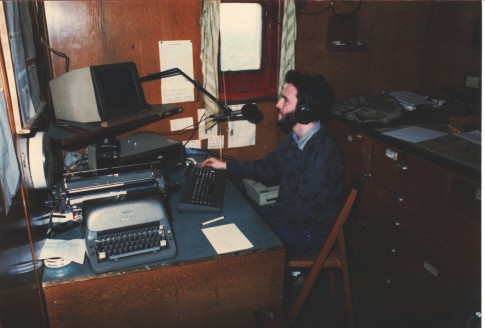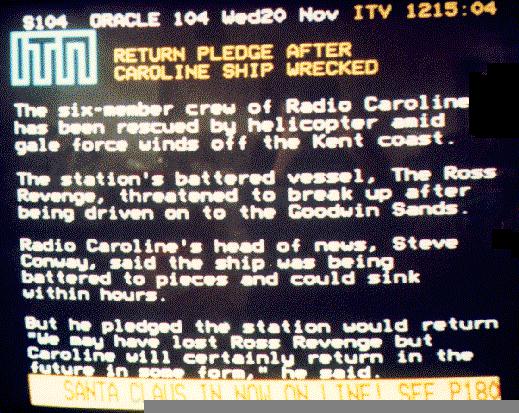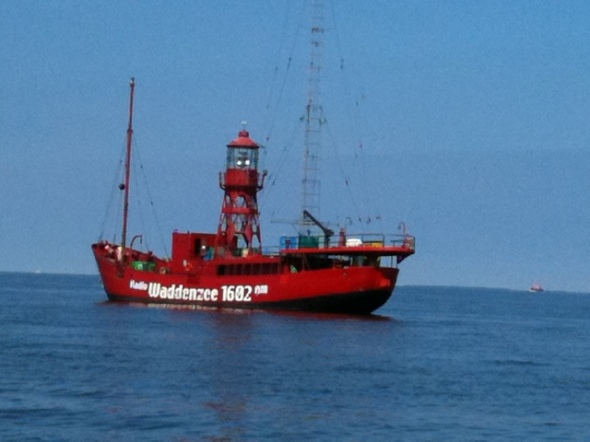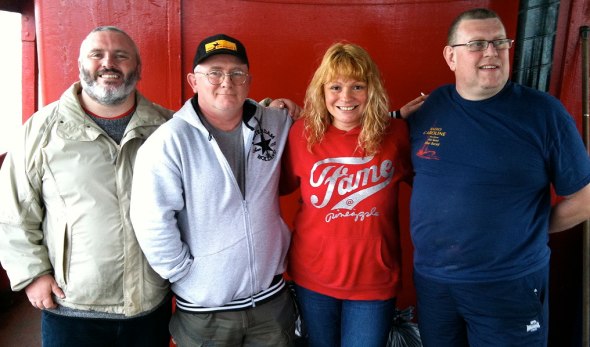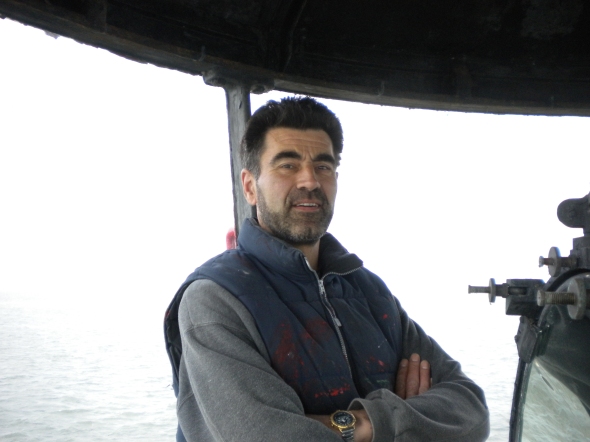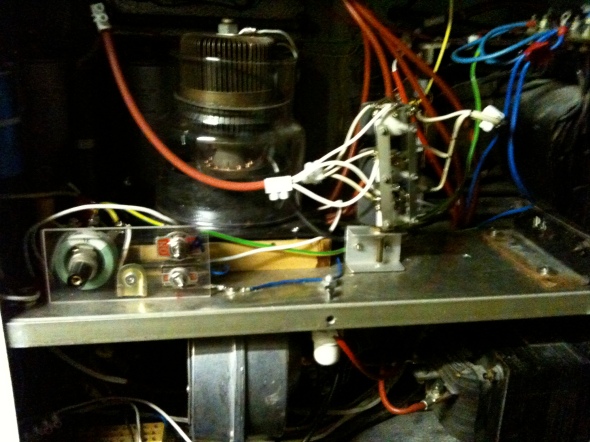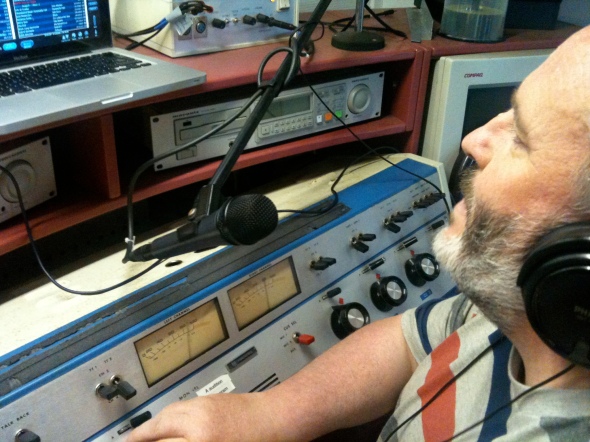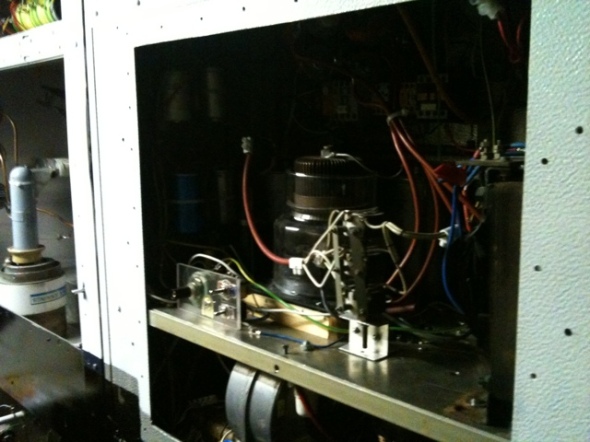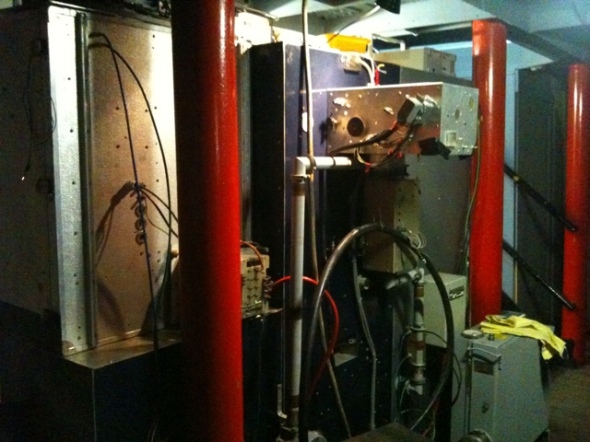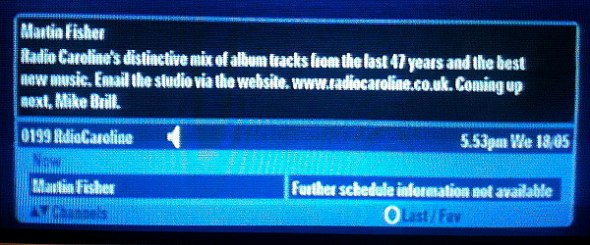Me And My Radio
Posted: March 21, 2013 Filed under: BBC, BBC Radio 4, broadcast engineering, radio, Technology | Tags: Apps, BBC, Computers, Fstream, Music, Names, Phantom 105.2, radio, Radio Caroline, Technology, Tranny 2 CommentsPocket radio memories . . and a new toy to play with.
I remember when I got my first radio. It was a little thing, not unlike the one pictured above, but with a big speaker grille occupying most of the front space (unlike the one pictured, which is designed to be used with headphones, but which is the nearest distant relative I still possess).
It was cheap, plastic, and could be held easily in one hand. The sound from it was a little tinny, but it was mine – finally I could choose my own listening, my own place, time, and station. The controls were simple – one wheel for volume (which also controlled on/off) and another for tuning. The radio being small, and the wheel sticky, tuning in stations, especially on FM, was almost an art form. And with cheap components it whistled and whined on AM, and would frequently de-tune from whatever station you were listening to.
Back in those days, you still referred to these things as a “transistor radio” – often shortened to “tranny“, which at that time either had not acquired the more modern usage as a gender related slur, or it was less commonly used. The “transistor” radio was one of those phases we go through linguistically, where we specifically incorporate the name of some new component into the name of a thing, even though most of the users would have little knowledge of what a transistor actually is, or how it differed from a non transistor radio. These technical names attach themselves to things for a period, and then eventually fade away, the transistor radio just becoming the plain old radio again.
Another good example of that is the “Microcomputer“, which, if you took it’s name as a literal meaning, would have been a computer so tiny that you would need a magnifying glass to find it on your desk. In fact, “Micro” computers were great big hulking beasts, taking up most of your desktop, and took their name from the then relatively new to mass market micro-processor at their heart. For a while in the early 80s, computer stores were always “Bill’s Micros” or “Sutton Micros” or “First Micro” etc, until the name gradually faded away to be replaced by the more prosaic “computer” of the desktop or laptop variety. Though of course, the biggest tech giant, which was born in those early PC days, does still carry the name – Microsoft.
Another example of such nomaculture, which has now almost faded away is the cellphone, which is what most mobile phones were initially called by users in the 80s and early 90s (and still are, to an extent, in the USA). This was again a case where the technical aspect of a product’s operation was included in the name – possibly by the designing engineers – and eventually being lost as generations of users, to whom the product is no longer a novelty, use them without any knowledge of the “transmission cell” technology which enables them to function.
Cellphones became mobiles, and just phones in many cases, and have now gained the title “smartphone” as they have started adding functionality not traditionally found on phones, such as mail, web-browsing, application support, and radio. How long will it be, I wonder, before the “smarts” of the smartphone are so taken for granted by users that they cease to have to be defined as smart, and become again, simply “the phone” ?
The arrival of radio onto mobile phones predated the smartphone era, and saved my bacon on one memorable occasion in 2009 when I was doing an outside broadcast for Phantom, and we suddenly lost the off-air monitor function on the desk. As I was not playing the music locally, but remote-controlling the playout system back at base through a laptop hookup, it was vital that I could hear what was going out on air, and i suddenly found myself adrift. Cue a few moments of panic before I realised that my trusty Nokia mobile could be pressed into service as an off-air monitor, though I’m sure it did our image no good at a very public location for me to be seen wearing, not the usual “big DJ headphones” but a tiny mobile with Walkman type personal earphones.
That was an FM radio facility, but mobile phones have moved on smartly since then, to the point where a variety of apps allow you to listen to online stations, or online feeds of terrestrial stations, from pretty much anywhere in the world, restricted only by occasional copyright issues. Most radio stations have their own app for ease of listening, and those that don’t are usually possible to get via specialised apps such as Tunein or Fstream (pictured above).
So a couple of days ago, I was lying in bed, enjoying what was, for me, a very rare lie-in. And I was listening to an online station through my smartphone. Nothing unusual in that . I use the phone for a lot of online listening: to get Radio 4 in good quality for example, or to listen to stations not available locally. But usually when listening, I am using headphones. In fact, I would virtually never listen to radio, podcast, or music on the phone any other way.
But lying in bed earphones are a drag, and I was feeling too lazy to get out of bed and go fire up the laptop to listen through the speakers. So I did something i rarely do, which was listen to the phone without headphones, through it’s own little speaker. And that’s when it hit me.
There I was, holding in my hand a device that was roughly the same size and shape as my first ever radio, though possibly a bit lighter. And I was listening to the radio on it, with that same slightly tinny sound that you get from small speakers, except that this was probably slightly better in that there was no whistles and de-tuning.
What I held in my hand at that moment was, to all intents and purposes, the portable “transistor radio” of old.
I know many radio purists of the old school who will disagree, and talk about receiving terrestrial signals. But to me that is not the point.
When I was a kid, I had a little box, and I could use it to listen to RTE, or BBC, or some other station I wanted to hear. Now, today, I can hold in my hand a box that allows me to do exactly the same. And more – If I want to, I can just as easily listen to Caroline or Radio Jackie or a station in Australia, all in the same quality, and without having to be in their specific area.
Just like the pocket radio of old, the battery will run down after a number of hours of listening. But instead of having to buy new ones, I simply plug in and recharge. And the phone allows me to do lots of other stuff too (though that is not the point of this piece).
The problem with internet radio always used to be it’s lack of mobility, as well as the fact that in pre-broadband days it could be clunky and intermittent to listen to. Better connection speeds solved the reliability issue, while the smartphone has essentially liberated online radio from the home, and allowed it to go with you. Wifi is nice, but not essential – as long as there is 3G coverage, most radio station apps will work just fine.
I remember doing online broadcasts 10 years ago, and at times it could be a pretty lonely show. The emails came in, but they could not be described as thick and fast. These days, working with Caroline, my response from online listeners vastly outnumbers satellite ones, and it seems to be almost as easy for people to tune in as it used to be.
It’s funny that I never made the connection between the smartphone and those old, little portable radios before. It took the removal of my headphones, and a sudden reversion to that lower sound quality of yesteryear, for me to make the emotional connection.
Broadcasting is not necessarily about aerials and signals, any more than good radio is about vinyl rather than CD.
Radio is about the content, the connection, the passion.
The old transistor radio was just a tool to deliver that content to me, just as the new age one in my shirt pocket does in 2013.
Steve
LW 252 Tower (Ireland) – Pics
Posted: March 17, 2013 Filed under: broadcast engineering, radio, Signs, Technology, Uncategorized, Weather | Tags: AM Broadcast, Anorak, Atlantic 252, Ireland, Longwave, Meath, radio, RTE, transmission towers, Warning Signs 4 CommentsSome shots of the 252Khz Longwave transmission tower in Co. Meath, Republic of Ireland, currently broadcasting RTE but originally erected for Atlantic 252. Pictures taken Sunday 17th March 2013.
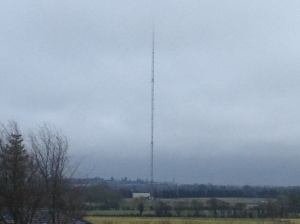
You can click on any picture for the high-res version. This is the tower as seen in the landscape of Co. Meath. It is actually a better shot than the close-up ones, as there are so many obstructions of the view from the roadway closest to the site.
I don’t normally go out of my way to photograph broadcast sites – I usually prefer to think and talk about the content rather than the technology – but a friend in the UK asked me for some pictures, and as I was walking in a forest only about 20km away today I thought “why not?”.

The base of the tower. This was taken through a wire mesh fence, and a small gap in the trees, so only possible to get one part of the tower at a time in shot.
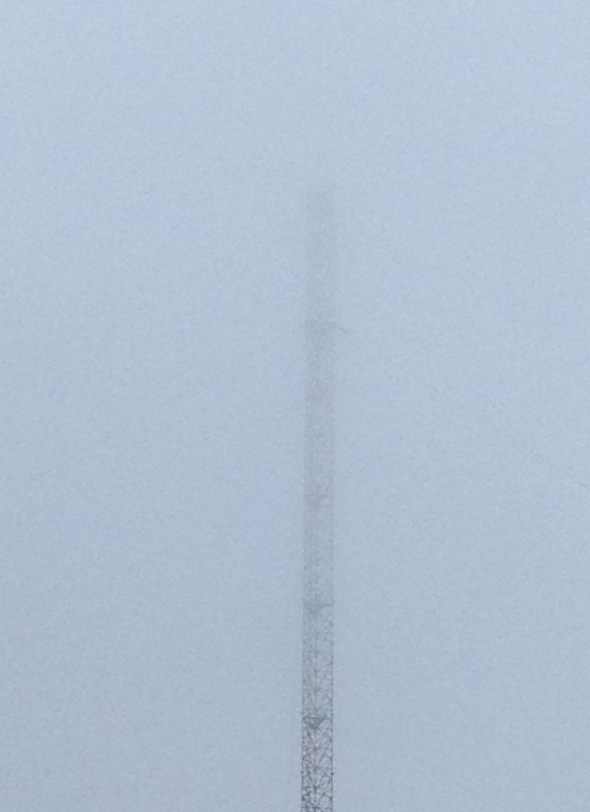
The upper sections vanishing into the mist. It is planned to paint the top 84m of this tower red and white, and to replace the current warning lights with ones of lower intensity.

Planning application notice on site for retention of modifications, also revised colour scheme and lighting.

When I last passed here about 15 years ago, it was very easy to see into the site, but the boundary trees planted around the tower have all grown up now.
So there you have it, 252 site on a typically misty St. Patricks Day.
Steve
String Theory: My Quarter Century As “Steve Conway”
Posted: February 24, 2012 Filed under: 1980s, 1987, broadcast engineering, Newsreading, offshore, Radio Caroline, Ross Revenge, Shiprocked!, Ships, Smartphones | Tags: 1987, Change, Information, life, Pirate Radio, Radio Caroline, String, Technology, Time, Travel 2 CommentsI think it was John Denver who sang the words “He was born in the summer of his 27th year, coming home to a place he’d never been before” (the song: Rocky Mountain High)
As Steve Conway I was born on the 6.30am news headlines exactly 25 years ago this morning, in the winter of my 23rd year, having just arrived at a place that would become home to me for a number of exciting drama and emotion packed years, and a sort of Tir Na Og or mystical lost land for me to look back at later in life.
This is a way of saying that today is the 25th anniversary of my joining Radio Caroline back in the days when it was offshore. Before that that day I had another name, but the practacalities of working on a radio station that was outside the law (not against the law, but actually outside it) made a name change advisible, and so Steve was born as a fully fledged adult, and Steve I have been ever since.
And, in a way, it was a rebirth of sorts, because joining Caroline so radically altered my life that the date 24th February 1987 is a dividing point in my life, which was very very different in shape either BC (before Caroline) or AD (after the drifting of November 1991 that ended my offshore years).
And what of the 4 years in the middle? They were, in a way, outside normal time and space – life on board a pirate radioship in International Waters being so strange and cut off from normal society, but so physically, socially, and emotionally intense that those involved seem to exist in their own little bubble. For a proper detailed description of those strange years, I would refer you to my 2009 book: Shiprocked – Life On The Waves With Radio Caroline, and my forthcoming prequel, sequel and midquel “Running Away From The Circus – Everything I Know About Radio I Learned By Screwing It Up”
No, what the anniversary has really made me think about this morning is time.
25 years – a quarter of a century. In one sense it has passed quickly, but in another, it is a very long span of time, especially if I view it in terms of the changes in the world in which I live.
I’m not talking about the micro world of radio – though that has changed dramatically, offshore pirates now a thing of the past, onshore radio multiplied in number by a huge factor – nor am I thinking about the political world, which, to be honest, despite governments coming and going, wars and alliences changing, is curiously unchanged from 1987 (I have a couple of my Caroline news bulletins on tape, and apart from the names of the participants, many of the actual stories would seem perfectly normal if broadcast today, indeed an old bulletin might almost be played out instead of a new one with few realising there was something wrong).
I’m thinking of the more general world as it personally affected me an an individual, then and now.
Information has been the defining change of those 25 years. In 1987, information was something which you were given, in limited quantities. It was not something which, in the run of the mill that you accessed, unless you have a job which specifically involved accessing files and databases.
On board the radio ship we had a television (and no, we didn’t have a licence for that either!) and it gave us the diet of entertainment and slices of news that were deemed suitable or needed for the population at large. There was no hint of customisation – you had the choice to watch or not, but could not influence that content in any way. Also on the TV was teletext, a few hundred pages of information judged to be of popular appeal, so you could look up things like sporting results, the current UK Top 40, news headlines, weather etc. No deeper dive into this information was possible, and there was no such thing as search.
Onshore it was not much different. You could go to a library, but getting hold of any kind of information outside the daily norm required a lot of effort. What exactly was said during a debate in the House of Commons last night? What are the times of the bus that goes past my friends house in a city 400 miles away? What is the history of Danzig before 1939? All of these kinds of questions were, indeed, capable of being answered, but not on the spot, not at 8am on a Sunday morning, and often not without considerable time and effort.
When I made the snap decision to join Caroline, my family and friends back home in Ireland did not find out about it for many weeks. There was no Facebook to keep in touch, no text messages, and no way for them to listen to me even if they had known I was on there.
Whenever I wanted to take a trip back to Ireland to see them, booking it was a big undertaking. I had to visit a travel agent or ferry or airline office, where first of all I would have to wait, patiently, while many other people in front of me were served, slowly. Then I would explain my needs to a person seated in front of a booking system which I could not see, and they would outline the various options of flights or ferries to me. I had no way of seeing those options myself, no way of knowing if what I was being told and sold was really the best for me, or the best for them.
When I went home to ireland, I was in a different world from the UK. No Caroline, no London Evening Standard, no access to my London friends other than making an international phone call (house to house in those days) which would seem . . well, strange.
I don’t have to tell you how vastly different all these things are now. I listened to Caroline on my way to work on the bus this morning in Dublin in clear FM quality via my smartphone, which will also give me the Evening Standard if I want it, let me search and book my flights, even act as my boarding pass. Any of the pieces of information I mentioned above are at my fingertips instantly. Travelling is hugely different, through apps and alerts I know what is going on at airports, can be certain when the next bus or tram is arriving, and can text Geoff in Surrey to tell him that I’m just about to get onto a fishing boat in Harlingen, Netherlands. Or research the history of Danzig should I be hit with a curiosity to do so at 8am on a Sunday morning.
When we look forward in time, we generally don’t see and can’t see the real changes which are going to happen. We think of faster planes and spaceships and wars for water, but we can’t forsee the changes that are gestating which will affect the more intimate, everyday world we live in.
There are other ways of predicting the future however. A couple of the Dutch crew on the Caroline ship had this thing going with a piece of string and a weight which they used to divine the future for the small but important events – such as when the next supply boat would arrive (FOOD! NEW FACES! NEW RECORDS!), who might be on it, and other such things.
The future was predicted based on which direction the string would move when held with the weight on the end, and whether it would stay absolutely still or move around.
The fact that we were doing this on board a ship which even in the calmest weather would move gently may tell you that we were not neccessarily applying the strictest of scientific methods here!
After a string (!) of successful predictions they started asking it some bigger questions.
Who would find love? Who would marry? When would the Ross Revenge make its final broadcast at sea? (the string correctly predicted 1990, but then wrongly told us that the ship would be bought by the Voice of Peace and move to the Israeli coast).
The human curiosity for the future is strong, despite our almost always predicting it wrongly. Looking back today at this junction in my life a quarter of a century ago, I can’t help but wonder what changes there will be in the next 25 years of Steve Conway. Hopefully, when “Steve” is 50 he will still be alive (his body will be 73, so that’s a reasonable hope). Beyond that I can’t really say what will happen.
Whereas before, everyone talked of flying cars, now in the information age we predict brain chips. People will be able to access everything without any external devices, our memories will be preserved forever . . .
But perhaps we are failing to see the real future, and the changes to come will be just as unexpected and profoundly altering as the ones of the last quarter century.
I just hope they are as liberating.
Anyone got a piece of string I can borrow?
Steve
Facing Death At Dawn . . And Life Afterwards
Posted: November 20, 2011 Filed under: 10 Things, broadcast engineering, Early Phantom, non-Fiction, offshore, Phantom 105.2, radio, Radio Caroline, Ross Revenge, Shiprocked!, Ships, storms at sea, Technology, Weather | Tags: Change, Goodwin Sands, International Waters, life, Life Changing Experiences, Pirate Radio, radio, Radio Caroline, Rescue, Storms, Survivor, UK, Weather 3 Comments
The past is indeed another country, but the future is a map that we can draw for ourselves if we dare.
It was 20 years ago this morning, (20th November 1991) that I came to the end of the roughest night I had ever known in all my years at sea with Radio Caroline, and faced what I came to believe would be my last ever dawn.
Aground on the infamous Goodwin Sands, which have claimed hundreds of ships and thousands of lives, we were gradually rolling over, each wave pushing us a little closer to the tipping point where the ship would capsize. Ironically, although there was not enough water to float her, there was more than enough to flood into her and fill her up if we went sideways . . more than enough to drown in.
The waves were towering in the North Easterly Force 11 winds, the seas icy – we wouldn’t have lasted more than a few minutes if we went over.
The brave men of Ramsgate Lifeboat had already tried to rescue us and failed, running aground themselves, losing a man overboard in the process (happily quickly recovered by safety line). Now we were waiting for the helicopter, but it seemed we would be in the water before it arrived . .
Certain that we would be drowning in minutes, the floor beneath us already at a 45 degree angle, we hugged each other, shook hands, and said goodbye. We knew we were going to our doom . .
The story of that morning, and our eventual rescue by the RAF helicopter R166 is described in detail in my book Shiprocked – Life On The Waves With Radio Caroline, but even the printed word cannot do justice to the memories which are still vividly seared onto my brain, even all these years later.
I absolutely believed that I was about to die, and that morning, and in particular that moment, has changed my life since then.
The 20 years I have lived since that morning on the Goodwins is a bonus, and the older I have got, the more I have appreciated this, and the more I have lived my life with zeast and purpose. The sudden seeming end of Caroline in 1991 (though not the final end, as it has bounced back and is adpating to a new age) instilled in me a knowledge of the impermanance of states of being, and ensured that when I got involved with Phantom FM in later years I treasured each moment, and drove myself to both give and take the maximum from every day that I worked there.
In life too, I reach out with lust for living to take the most from each day, and push myself to do and experience more and newer things.
Life is a bonus, and I am determined to spend that bonus to the full.
Many people around me comment on my seemingly unflappable calm when faced with difficult situations. This too comes from that morning on the Goodwins, for as I see it, I have been minutes from an icy drowning death, so why should anything that happens in a more normal work or life based situation cause me to panic?
Time has been kind to Radio Caroline too, and that morning, seemingly a point of closure for the station was to be in fact the first step in forcing it to adapt to a new path, which though seemingly bleak for much of the 1990s, has blossomed in latter years into an unprecedented period of stable broadcasts, with new technology enabling the station to be heard in undreamed of quality in previously unreachable countries.
20 years on I have spent the night of the 19th/20th November sipping wine with close friends, and thanking my lucky stars for all the richness of life and the benefits of new technology that both I and Radio Caroline have enjoyed in the last 20 years.
It’s right to raise a glass and look back, but the biggest gift of all is to be able to raise my gaze and look forwards.
Steve
1395 tests reach Ireland in final week
Posted: November 10, 2011 Filed under: broadcast engineering, offshore, Posts with Audio, Radio Seagull | Tags: AM Broadcast, Broadcast Engineering, Ireland, radio, Radio Seagull, Test Transmissions, The Netherlands Leave a commentHave a listen to the tests of the custom-built AM valve transmitter on board the Radio Seagull ship in Harlingen, Netherlands, as picked up more than 300 miles away in Co. Kildare, Ireland
I reported during the summer on the construction of a custom built, old-style valve transmitter for high-power AM on board the Radio Seagull ship, the Jenni Baynton, located near Harlingen, in the northern Holland. For the last 6 weeks this transmitter has been in use, performing authorised tests on the 1395AM frequency, which is licenced to a different operator. During these tests Radio Seagull has been relayed, and they come to a close after this weekend (14th November 2011) after which Seagull will continue to be heard on its own frequency 1602Khz and online worldwide.
For the last week, the transmitter has been operating on a higher power setting, and in addition to providing coverage throughout The Netherlands (the intended coverage area) it has been possible to listen much further afield, the signal reaching many parts of the UK, and latterly Ireland.
Click on the link below to hear a short (1 minute) sample of reception on an ordinary car radio, at Monestrevin, Co. Kildare, at around 5.45pm on Monday 7th November. This recording was made simply by using to “voice memo” function on my mobile phone to record the sound inside the car, so the original reception quality is even better.
Not a bad reach for a hand-built rig on a little lightship. Kudos to Walter, Colin, Sietse and the the onboard engineering staff on the Jenni Baynton.
Steve
So Who Are Radio Seagull?
Posted: October 24, 2011 Filed under: broadcast engineering, Classic Rock, Music, New Music, offshore, Radio presenting, Radio Seagull, Ships, storms at sea, Weather | Tags: Music Radio, Offshore Radio, radio, Radio Seagull, Ships, The Netherlands, Transmitters, Waddenzee 1 CommentThe recent test-transmissions on 1395Khz by Radio Seagull have driven quite a few Google search requests to this blog, so I’ve decided to give a quick run-down on the station for any new visitors, as well as for those who follow me for my other content and might be curious.
Please note my disclaimer: I am a Radio Seagull presenter myself (Saturdays 7-9am and pm CET, 6-8am and pm UK/Irish time) so you are reading an insider rather than an outsiders point of view. Having said that, I also have to point out that all views are my own, and not neccessarily endorsed by the station.
So, what is Radio Seagull?
Radio Seagull is a full-time, permanent, licenced terrestrial, English-language radio station based in The Netherlands, specifically the town of Harlingen, in the northern coastal area. As well as AM coverage emenating from Harlingen, the station can be heard worldwide via its online stream, accessible from the station website – www.radioseagull.com
How can I hear Radio Seagull?
In The Netherlands the station shares its AM frequency (1602Khz) with Radio Waddenzee, a regional station servicing the north of The Netherlands in the Dutch language. Waddenzee is heard from 7am-7pm and Seagull from 7pm to 7am on mediumwave, however Seagull is available 24 hours a day online.
(Radio Waddenzee takes its name from The Wadden Zee, a large area of sea on the fringe of the North Sea, but partly protected by a chain of islands 20km or so from the coast.)
As well as terrestrial and online outlets, Radio Seagull is sometimes carried as a sustaining service on other stations around the world. Currently the station is being relayed as the content of a series of test transmissions on 1395Khz on AM, which are being made from the Radio Seagull ship, the Jenni Baynton. These are scheduled to continue until mid-November (but Seagull will continue to be available on its permanent frequency of 1602Khz, at all times).
What type of programmes does Radio Seagull have?
Radio Seagull features both modern alternative and classic rock, as well as a wide variety of specialist music shows. Some presenters specialise in new and alternative music, others present more general shows. Details can be found at the website www.radioseagull.com.
In order to cater for international listeners in different time-zones, the schedule is organised into groups of programmes in 12-hour blocks, repeated once the same day – so that, for example, a show aired at 3-5pm will also be aired at 3-5am, giving people in different parts of the world the chance to hear each show in their “daytime”.
How is Radio Seagull different from other stations I can hear on the internet, or local stations on FM?
Radio Seagull’s programming philosophy is to gather together experienced and professional presenters from around the world, people who are passionate about the music they play, or very knowledgeable in their specialist area, and to give them complete creative freedom to produce the best shows that they can. Unlike larger commercial radio stations, there is no restriction on playlist size, and as a result the music you hear on air is incredibly diverse and wide-ranging.
Presenters come from all across Europe and further afield to work on Seagull, and many are people who have been involved in radio for a long time.
So what’s all this about a ship?
Radio Seagull (and its sister station Radio Waddenzee) are housed on board a former British Lightship (LV8), the Jenni Baynton, which is normally berthed in the harbour at Harlingen. The ship itself is an attraction, bursting full of history, and much restored since its acquisition by Seagull in the early 2000s, and it makes a wonderful base for the radio station – lots of room for studios, engineering facilities, radio mast, and cabins where crew and visiting DJs can be accomodated during special offshore broadcasts. The station also has landbased transmission facilities.
But the ship is more than just a static base.
Once a year, for the last several years, the station has put to sea for periods of about a month each summer, with crew and DJs living on board, a great opportunity for friendships to be rekindled and knowledge to be swapped, as well as recreating some of the excitement of the old offshore radio days (a number of the Seagull presenters, myself included, are veterans of the former offshore pirate stations such as Radio Caroline).
Who is behind Radio Seagull?
Seagull is the brainchild of Sietse Brouwer, a Dutch businessman and radio presenter who also spent some time working with Radio Caroline in the 1990s. Sietse has a passion for good radio, and a great love of ships, and putting the two together in his home town of Harlingen has occupied a great part of his time for the last 10 years.
Where can I get more info / how can I listen?
The best place to start for both is the website – www.radioseagull.com
You can also see more of my pictures from Radio Seagull’s offshore adventures at the following pages:
https://steveconway.wordpress.com/seagull/the-jenni-baynton-at-sea/
https://steveconway.wordpress.com/seagull/inside-the-jenni-baynton/
https://steveconway.wordpress.com/seagull/jenni-baynton-crew/
https://steveconway.wordpress.com/2011/06/07/dreamy-seagull-pics/
If you are a new visitor, I hope this has answered your questions, and made you curious enough to listen.
I can be heard every Saturday 7-9am and pm CET, (6-8am and pm UK/Irish time).
But don’t just listen to me – the rest of the presenters are superb!
Steve
Seagull to test on 1395khz
Posted: September 30, 2011 Filed under: broadcast engineering, Music, offshore, Radio Seagull, Ships | Tags: AM radio, radio, Radio Seagull, Test Transmissions, The Netherlands, Transmitters 4 CommentsHi all,
A little while back I wrote about the lovingly handcrafted AM transmitter being built onboard the Radio Seagull ship Jenni Baynton during the summer. Now I am pleased to report that you will be able to hear it in action.
Starting tomorrow, 1st October 2011, the ship will be used for test transmissions on 1395Khz AM at various power levels, for a number of weeks. During this time, the programmes of Radio Seagull (already available on 1602Khz AM) will form the content of the test transmissions.
These tests will run 21 hours a day, as due to international agreements the frequency 1395Khz cannot be operated in The Netherlands from 2000-2300 CET (1900-2200 UK/Irish time).
As these tests will be at times on higher power than the existing 1602 service, you may find that you are able to pick us up further afield than usual.
Reception reports will be appreciated – full details and regular news at the Radio Seagull website.
And don’t forget, you can catch my Saturday show on Seagull every week, from 7-9am and 7-9pm CET (that’s 6-8 am and pm in UK/Ireland) featuring the best in indie and alternative rock, with at least 50% of the show devoted to brand new releases, including unsigned bands.
As well as the two AM frequencies, you can listen online anywhere through www.radioseagull.com
Steve
Lovingly Crafted New (Old) AM Transmitter
Posted: June 10, 2011 Filed under: broadcast engineering, offshore, radio, Radio Seagull | Tags: AM Broadcast, equipment, radio, Radio Seagull, Ships 8 CommentsOK, this one is for the more technically minded radio enthusiasts.
Out here on board the former lightship Jenni Baynton, our engineer Walter Gralle has been building a copy of one of the old-fashioned high-power AM transmitters as used on the offshore stations of the past. This is similar, apparently, to a transmitter used on the Caroline ship Mi Amigo in the 60s.
Below are some photos of this magnificent piece of valve- driven transmitting equipment, which is nearing completion.
Enjoy!
Steve
In Context: Radio Caroline’s brave (but wise) move to exit Sky EPG
Posted: May 20, 2011 Filed under: broadcast engineering, radio, Radio Caroline | Tags: Change, EPG, Internet Radio, Radio Caroline 3 CommentsNews this week from Radio Caroline which has confirmed today that it will be leaving the Sky EPG (Electronic Programme Guide) in a calculated move to focus its media spend on the forms of distribution which are most productive in terms of audience. The station will continue to broadcast on a satellite channel, which will be available by manual tuning, details of which are to be announced later.
The Radio Caroline statement:
Our recent survey into the listening habits of our audience has shown that only a small percentage are listening using SKY 0199.
The findings duplicated the results of a similar survey we carried out 2008 but showed satellite listening had fallen by a further 9%. At the same time on-line listening has increased by around 40% and continues to grow. This information came as we were considering whether to also obtain an EPG on FreeSat.
As a result of this we have tried, but without success, to renegotiate prices with both providers. Therefore we have decided not to proceed with FreeSat and to give up our SKY 0199 Electronic Programme Guide. This change may happen either soon, or in the medium term.
We will still have a presence on satellite but this will require manual tuning. It is hoped there will be no interruption to the service, but there may be a brief period of satellite silence while the changes are made. We will then explain how to tune Caroline in manually via SKY, FreeSat and any UK standard satellite receiver.
When the required information is provided to us, we aim to set up a dedicated telephone help line to assist listeners affected by the change. Information will also be on the web site.
There is a substantial cost saving that will result from this decision and we hope that this can be used for future expansion and to improve our current facilities.
As a presenter with Radio Caroline in both its offshore days and the current day operation, and as one of the people involved in the start-up of the satellite service in 1999, I can tell you that, despite a little apprehension at first, I can embrace this move as a positive step for the station.
When Caroline started its regular and ongoing satellite transmissions in early 1999 (taking in its own right a channel vacated by EKR, from whom it had been leasing airtime for the previous six months) satellite was pretty much the only game in town for moving forward on a legal footing, unless you wanted to sell out to corporate investors. Internet broadcasting, while technically an option, was in the most embryonic of states, with pretty dreadful quality, very limited numbers of streams, and dial-up connections making the listening experience one of limited bursts of music followed by “buffering” for most people.
In recent years, ever-increasing access speeds and technological advances in consumer hardware has changed the game profoundly, to the point where even TV (with its much greater bandwidth demand) is watched online frequently. (One example of this is that, according to official figures, 1 million people watched the latest episode of Doctor Who online via the BBC’s iPlayer within a week of broadcast).
There is now no real barrier to being able to serve listeners professionally online, and the advent of wifi radios and smart phones has made things even easier. I now routinely listen to Radio Caroline in the car in Dublin via an iPhone hookup, in a close to FM quality that is better than anything we could have wished for in our offshore days. And it’s not just Caroline that I listen to this way – BBC Radio 4 can now be listened to in areas outside its longwave coverage, and I use the iPhone to listen to the evening news on RTE Radio if I am travelling by public transport.
Broadcasting live from the Ross Revenge recently, I was delighted to see how many people were listening from all around the world – the USA, South America, Tokyo, Australia – where there is the net, now there is Radio Caroline. By far the vast majority of emails were from people listening online. Here in Dublin, many people I know listen to radio online via apps or wifi radios, but none use the Sky option (or are even aware that it is there – I’m talking “normal”, non-radio people here).
With such a growing and international audience for radio online, it now makes real business sense for Caroline to stop paying a huge five-figure sum just for the benefit of a few inches of screen space on the EPG, and concentrate that money on maintaining and improving the service in more productive ways. And, of course, the satellite will be there too, as a manually tuned option – just as it was for most of the early 2000s.
It’s very easy to cling to the familiar, but to survive in any business you have to not only become good at doing what you do, but also to know when changing what you do is the right thing to do.
Stay tuned to Radio Caroline for details of upcoming changes – via www.radiocaroline.co.uk – and keep enjoying the great album tracks from the last 47 years.
Steve
Steve now adfree, and more noisy.
Posted: May 8, 2011 Filed under: 1980s, 1987, broadcast engineering, offshore, Radio Caroline, Radio presenting, Ross Revenge, Shiprocked!, Ships | Tags: Newsreading, Pirate Radio, Radio Caroline, Ships 3 CommentsJust a very quick note – I’ve paid for a couple of upgrades from WordPress to enhance the enjoyment of your visits.
As of today, we are ad-free, so there will no longer be adverts popping up for services that are beyond my control.
I’ve also upgraded the storage space which adds the ability for me to directly host audio on the site, so I can now include clips of off-air recordings etc if they add to the article.
By way of trial, below is a clip from half a lifetime ago, back in my newsreading days with Radio Caroline, at sea on board the ship Ross Revenge. The microphones and audio processing used on Caroline were very good at pulling in background noise whenever there was silence, hence the fact that on music programmes we tried to always speak over song fades and intros rather than dead air. This was not possible in the news of course – just listen to the amount of ambient ship noise (mostly generator rumble) being pulled in behind me on this bulletin – not to mention how dilligently the system amplified my between sentence wheezes!
noisy-news-24Oct1987 (this opens as an mp3 clip)

Steve Conway in the Caroline newsroom in late 1987, around the same time as the recording. This was originally the ships chart-room, off the bridge, and unlike the main studios, had no soundproofing.
We could have used a news bed (music behind the news) but a huge poportion of the audience find this really intrusive, so we lived with the background noise instead! The location of the newsroom just off the bridge, the closest to the generator room of any of the on board studios, did not help either. The best studio on board for silence was studio 2 (the “overdrive” studio) situated right at the back of the ship. On the clip, the news is followed by Peter Philips reading the latest Lotto 6/49 results (the Canadian Lottery was our biggest advertiser at the time) – this would have been pre-recorded in studio 3, and you’ll note that although generator noise is much reduced, it can still be heard in the background between sentences.
Anyway, I shall add in the odd audio piece here from time to time, and hope that you continue to visit and enjoy this blog.
Steve
A few more Tilbury pictures
Posted: May 1, 2011 Filed under: broadcast engineering, radio, Radio Caroline, Ross Revenge, Ships | Tags: Radio Caroline, Ships Leave a commentI’m safely back home in Dublin now after an amazing week’s live broadcasting from the Radio Caroline ship Ross Revenge at Tilbury Port.
Below are a few photos that I didn’t get around to uploading in my earlier live blogs from the ship.
Bigger versions are available by clicking on the picture in each case.

What a tangled web we weave - all this steelwork (x 2 - one either end of ship) was needed at sea just to hold up the thin strands of aerial wire

The lock gates that protect the water level in Tilbury Port. The M25 Dartford Crossing bridge can be seen in the distance

My last view of the Ross as I left after my show in the early hours of Friday morning, April 29th 2011.
Why On The Ship?
Posted: April 26, 2011 Filed under: broadcast engineering, Classic Rock, Listeners, offshore, radio, Radio Caroline, Radio presenting, Ross Revenge, Shiprocked! | Tags: Music, Pirate Radio, Radio Caroline 2 CommentsI’m now halfway through my week on board the Ross Revenge at Tilbury Port in Essex as part of the 11 days of live ship- based broadcasting to celebrate Radio Caroline’s 47th birthday.
I’m having a great time on board, along with other ex-offshore folk such as Dave Foster, Bob Lawrence, Cliff Osbourne, Jeremy Chartham and others. And we are joined by a new generation of people who have come to Caroline in the post-offshore years, including an amazingly talented presenter and engineer called Ollie, who is about the age that I was when I joined Caroline, and keen as mustard.
Caroline has been on Sky for 12 years, and these days gets a huge proportion of listeners online through streams and apps, and we have emails coming in from all around the world.
So why keep the ship? What purpose does it fill when we are no longer required to be in international waters in order to reach out and touch our audience? Those are questions that would be asked in the business world, where the upkeep of the Ross Revenge would be an “opex” problem.
Well, ignore for a moment the fact that this ship, and the others that preceeded it are to an extent hardwired into the DNA of Radio Caroline. Ignore the fact that every room, every corridor and every nut and bolt on the ship is infused with our history, our memories, and our dreams. Ignore these things, as although they are substantial and important, that could be said to be based on emotion and sentiment.
Even without tear things, returning to the ship to broadcast brings a unique benefit to the station which translates into better programmes and a better “buzz” for the audience.
Living on board during a broadcast, presenters who never normally see each other are forced into close proximity and develop a bond that dies wonders for the overall sound of the station. We wake together, breakfast together, work alongside each other all day, listen to each other’s shows and spend evenings laughing and debating in the record library, where old tall tales and new music releases are swapped in equal measure.
We bounce off each other musically, emotionally, technically. We share our passion and as we share it, that passion grows. A passion for music, for radio, for communication.
The ship is the soul of Radio Caroline, and the ship-based broadcasts let us get in touch with that soul, and drink deep at the well of friendship and creativity.
There are some thing that never appear in the financial entries of a corporate spreadsheet, but which are beyond value nonetheless.
As I write this, Cliff Osbourne is playing “Goin’ Back”
“A little bit of freedom is all we lack
So catch me if you can, I’m going back”
Steve Conway
M.V. Ross Revenge
Tilbury Port
April 2011
You never know what’s just around the corner
Posted: June 14, 2008 Filed under: 1980s, 1987, broadcast engineering, offshore, radio, Radio Caroline, Ross Revenge, storms at sea Leave a comment(originally posted on 25th Nov 2007)
So here I am sitting in Phantom Towers waiting to do my usual Sunday evening 7-9pm slot. Life is pretty good at the moment, I’m enjoying work, loving Phantom and managing to get by OK in all the other areas of my life.
It was only as I signed in to the building this evening that I realised the date – 25th November. Exactly 20 years since a very eventful day when a lot of things changed . . .
Life was pretty good at that time too, at least up to that day in November 1987. I’d been working on board Radio Caroline for about 9 months at that stage, and had progressed from bumbling newbie newsreader to something at least passably presentable in the newsroom. I hadn’t really got the hang of being a music presenter or DJ though, despite some overnight stints at weekends I wasn’t very confident, and it was probably a good thing that Caroline’s format demanded that you keep your mouth shut most of the time.
(the full story of my years at sea with Radio Caroline is in the book)
I had just come off the ship about two weeks earlier, after a marathon 101-day stint at sea, which had included being on board for the famous October 87 “Hurricane”.
Caroline’s owner, Ronan O’Rahilly had roped me in to do some running around on land while I was on shoreleave, as there was so much going on at the time.
Caroline in 1987 was going through a very strong period, our main English service on 558 was running reliably and had increased power the previous May, the Dutch station on 963 was paying all the bills, and we had just started test transmissions on shortwave, with the aim of launching a new service in Dec ember which could be hired out to religious broadcasters to bring in even more money.
Even bigger things were afoot – a new 50kw medium-wave transmitter was on its way from the US which would more than quadruple our power on 558, and allow us to use the existing transmitter on another frequency to launch yet another new service, probably a 24×7 country music channel.
We had just done a deal with MAN in germany to supply a new half a megawatt generator we we need to power all the extra transmitters and studios, and all sorts of other stuff was going on.
On the 24th November, I worked busily recruiting extra staff for the winter – always difficult to get people to live on a pirate radio ship in the winter months – and running other errands for Ronan.
That evening two major pieces of good news came in – a new advertising contract with Island Records, and another with the government of a Caribbean nation who wanted a two-year campaign to encourage tourism.
Things just couldn’t be better.

When I woke up the following morning, on the 25th of November, it was all gone.
Our 300 foot broadcast tower, the tallest mast on any ship in the world at the time, had come tumbling down in the middle of the night, apparently fatigued in the October Hurricane, breaking off at the base just 3 inches above deck level, and plunging into the sea. Parts of the mast and the dozens of steel stay-wires had caused enormous damage all over the ship as they fell, while in the transmitter room, a giant feed-insulator had plummeted from the ceiling destroying tens of thousands of pounds of equipment below before smashing into pieces.
It was just about the worst possible thing that could have happened to us at the time short of an actual shipwreck, and it not only put us off the air, but inflicted long term damage to our plans which never really healed in the remaining 4 years that Caroline was at sea.
When we came back, we were on such pitiful low power that we could hardly be heard, and it took 3 months of hard work in the bitter cold of a north sea winter before we had built new masts and an aerial system good enough to return us to our previous coverage. And this happened at exactly the same time as BBC Radio 1 were getting their own FM frequencies for the first time, encouraging a mass migration away from mediumwave

The photo above is ironically one of my favourites, despite being so dark and gloomy. It is taken a couple of weeks after the disaster, and shows engineer Mike Watts and myself (I’m the one on the right) standing on the back deck of the Ross on a very bleak and cold December morning, with damage caused by the fall still clearly visible around us. In the background you can see the tiny temporary aerial array (dubbed ‘the coathanger” ) which was rigged to get us back on the air on very low power. I love this photo because, for all the sunny images of brightly painted ships and smiling DJs, this cold, weary, shattered look is part of what those days were about too.
We did recover over a period of months, (see photo below for our more permanent repair work – all built at sea) but the grand plans and the big advertising deals had been lost in the meantime.
I was to stay with Caroline on and off for another 4 years, eventually being one of the final crew on board when we were shipwrecked in 1991, also in a November gale.

I learned many lessons from Caroline in my time there, but the one that is strongest is this: always treasure what you have today, and give it your all, for you never know what is just around the corner.
It’s always at the back of my mind, but it’s on cold November nights when the wind blows strong, that I remember it most.
However, despite everything, some good came from that bitter winter. So many staff had chosen to leave Caroline when the mast fell and times got hard, that I was left with no option but to become a full-time presenter on daytime slots on the station, as there was simply no one else to cover the programmes. And somehow, the fact that it was either me or nothing, made me lose my fear of being on air as a DJ, and I gained confidence and never looked back
Out of all adversity, some good will come, and that’s something I learned from Caroline too






